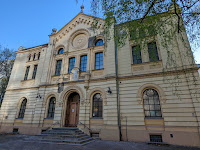|
Torah Portion: |
Tazria-Metzorah
(Rosh Chodesh) |
|
Synagogue: |
Nozyk
Synagogue |
|
Walking time from hotel: |
12-15 minutes |
|
Reason for going: |
Main shule in
town |
|
Kiddush: |
N/A |
WARSAW, POLAND: As we have learned all week in Poland, this country used to be filled with Jews, synagogues and institutions of the Jewish community. Jews have been in Poland for nearly a thousand years, and at one point, this was the centre of the Jewish world, with up to a third of the entire population Jewish. Since so many of the Jews were religious, there were plenty of synagogues, and in Warsaw alone, close to 400.
Today, after the annihilation of 3.3 million Polish Jews during the Holocaust, there are many remnants of Jewish life, but few functioning synagogues. Yet despite that, in the last few decades there has been a revitalisation of sorts, and some people feel comfortable to show and practice their Judaism for the first time in their lives. In Warsaw, despite it being the capital and the biggest city, of the 400 shules of old, there is now just one surviving house of worship – and a newer Chabad shule in a different part of the city. Not only did the Nozyk Synagogue survive, it is large, beautiful and a perfect place to come and see the revitalisation of Jewish life in Warsaw, especially this week.
On a regular Shabbat, they have 45-50 congregants in a space that holds ten times as many. The shule was built at the turn of the 20th century and survived because it was inside the ghetto and large enough to act as a warehouse for the Nazis during the war. Immediately after liberation it was converted back into a synagogue and refurbished in the Byzantine and Moorish styles in which it was originally designed. It now serves not only as a monument to the Jewish life of the city before the war, but also as the central synagogue of Warsaw. As such, when March of the Living is in town, this is the place to be.
Luckily I arrived early enough to be let in and to get a seat. Others from our group had to wait outside until some people left before they could enter. All of the pews were filled, as were many of the aisles. It is not an exaggeration to say that the shule was rocking. Though there were not enough books to go around, when it came to some of the better known songs, it is likely that every person in the room sang along, and the cacophony of voices, accents, styles and pronunciations was glorious, inspiring and such a wonderful antidote to the experiences that we have had this week.
This week was actually a double Torah portion and there were also other additions for the first day of the new lunar month. In a shule without atmosphere, the service would’ve felt long, boring and almost interminable. But on this day in this place, time seemed to fly and the representatives of so many delegations from all over the world all in one place for the purpose of worship and tradition, made the service feel perfectly timed.
There was a kiddush being set up in a back room, but we were told that was only for locals. We didn’t mind because we had a lunch set for us back at the hotel, and as we walked back, I saw smiles on so many of the faces leaving the shule. It was a genuinely joyous experience for all.
But as I walked back I also thought about the people who had occupied the same pews a century ago, and also about the local people who come to this place every other week of the year when we are not around. To see some of that, I came back later for the afternoon service, and though there were some visitors at that service too, the majority were Polish Jews, and it felt entirely right to see them, to hear them speak the language of this country and to engage so openly in such a beautiful setting.

Comments
Post a Comment